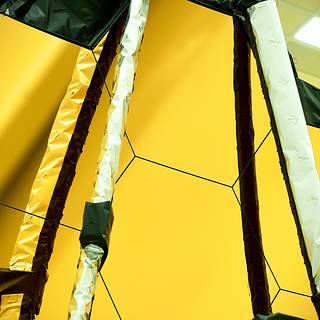China's Chang'e-5 mission offers new insights into evolution of Moon
Thursday, 21 October 2021 09:18 Chinese researchers have studied the lunar samples brought back by the Chang'e-5 mission and dated the youngest rock on the Moon at around 2 billion years in age, extending the "life" of lunar volcanism 800-900 million years longer than previously known.
The study, conducted mainly by a research team at the Institute of Geology and Geophysics (IGG), Chinese Academy of Sciences (CAS), was p
Chinese researchers have studied the lunar samples brought back by the Chang'e-5 mission and dated the youngest rock on the Moon at around 2 billion years in age, extending the "life" of lunar volcanism 800-900 million years longer than previously known.
The study, conducted mainly by a research team at the Institute of Geology and Geophysics (IGG), Chinese Academy of Sciences (CAS), was p NEID Spectrometer Lights Up Path to Exoplanet Exploration
Thursday, 21 October 2021 09:18 As NASA expands its quest to discover exoplanets - planets beyond our solar system - it also grows its toolbox. Over the summer, a new tool called NEID (pronounced NOO-id) delivered its first batch of data on the nearest and best-studied star, our Sun.
The NEID spectrometer, which will help locate and characterize new worlds, observes the sky from Kitt Peak National Observatory in Arizona.
As NASA expands its quest to discover exoplanets - planets beyond our solar system - it also grows its toolbox. Over the summer, a new tool called NEID (pronounced NOO-id) delivered its first batch of data on the nearest and best-studied star, our Sun.
The NEID spectrometer, which will help locate and characterize new worlds, observes the sky from Kitt Peak National Observatory in Arizona. China may boost accuracy of its hypersonic weapons via AI technology
Thursday, 21 October 2021 09:18 Chinese PLA researchers are reportedly seeking to improve the accuracy of the country's hypersonic delivery systems via artificial intelligence, according to the South China Morning Post.
Chinese Foreign Ministry spokesman Zhao Lijian on Monday refuted a report by the Financial Times saying that the country conducted a hypersonic missile test in August. First, it was not a missile but a sp
Chinese PLA researchers are reportedly seeking to improve the accuracy of the country's hypersonic delivery systems via artificial intelligence, according to the South China Morning Post.
Chinese Foreign Ministry spokesman Zhao Lijian on Monday refuted a report by the Financial Times saying that the country conducted a hypersonic missile test in August. First, it was not a missile but a sp From Polar Bears to Polar Orbits
Thursday, 21 October 2021 09:18 Alaska is known for its polar bears, rugged landscapes, expansive areas and remoteness. Alaska is not the first place people envision when they think of rocket launches. However, Alaska is one of four locations in the United States that allow a rocket launch into polar orbit.
In fact, the Pacific Spaceport Complex-Alaska ("PSCA") operated by Alaska Aerospace Corporation has been launching
Alaska is known for its polar bears, rugged landscapes, expansive areas and remoteness. Alaska is not the first place people envision when they think of rocket launches. However, Alaska is one of four locations in the United States that allow a rocket launch into polar orbit.
In fact, the Pacific Spaceport Complex-Alaska ("PSCA") operated by Alaska Aerospace Corporation has been launching Three new Directors join the European Space Agency’s Executive Board
Thursday, 21 October 2021 07:50
As of today, ESA has appointed three new Directors - for Commercialisation, Industry and Procurement, Earth Observation Programmes and Navigation. The new Directors were appointed by ESA Council at its meeting on 21 October; they will support the Director General with responsibility for activities and overall objectives in their respective directorates.
South Korea launches first domestic space rocket but mission fails
Thursday, 21 October 2021 07:15
South Korea launched its first domestically developed space rocket on Thursday but failed to put its dummy payload into orbit, a setback in the country's attempts to join the ranks of advanced space-faring nations.
The Korea Space Launch Vehicle II, informally called Nuri and emblazoned with a South Korean flag, rose upwards from Goheung on the southern coast trailing a column of flame.
All three stages of the rocket worked, taking it to an altitude of 700 kilometres, and the 1.5-tonne payload separated successfully, President Moon Jae-in said after watching the launch at the control centre.
But "putting a dummy satellite into orbit remains an unfinished mission", he announced.
"Though it fell short of achieving its goals perfectly, we have achieved very good feats with our first launch."
Another attempt will be made in May, he added.
"Countries that lead in space technology will lead the future. And we are not too late to do it."
The mission failed because the third-stage engine stopped burning 46 seconds earlier than scheduled, science minister Lim Hye-sook told reporters.
Living Planet Symposium 2022: time for abstracts
Thursday, 21 October 2021 06:05
ESA’s next Living Planet Symposium is set to take place on 23–27 May 2022 in Bonn, Germany. In gearing up for this prestigious event, it’s now time to submit abstracts to ensure a much sought-after slot to present topics such as the latest scientific findings on our planet, novel Earth observing technologies and new opportunities emerging in the rapidly changing sector of Earth observation.
NASA defends decision to retain JWST name
Wednesday, 20 October 2021 21:20
NASA officials are standing by their decision to retain the name of the James Webb Space Telescope despite criticism from some astronomers, including one who resigned from an advisory committee in protest.
Blue Origin eyes participation in military ‘rocket cargo’ program
Wednesday, 20 October 2021 19:34
Blue Origin is considering entering a cooperative agreement with the U.S. military to examine how space vehicles might be used to transport cargo around the world.
Rodolphe Belmer to step down as Eutelsat CEO in 2022
Wednesday, 20 October 2021 19:07
Rodolphe Belmer plans to step down as Eutelsat’s CEO at the beginning of 2022 after six years with the French satellite operator.
NASA challenges K-12 students to design moon-digging robots
Wednesday, 20 October 2021 18:38
NASA seeks young engineers to help design a new robot concept for an excavation mission on the Moon. The Lunabotics Junior Contest is open to K-12 students in U.S. public and private schools, as well as home-schoolers.
The competition, which is a collaboration between NASA and Future Engineers, asks students to design a robot that digs and moves lunar soil, called regolith, from an area of the lunar South Pole to a holding container near where Artemis astronauts may explore in the future.
As part of the Artemis program, NASA will land the first woman and first person of color on the Moon and establish long-term lunar science and exploration capabilities that will serve as a springboard for future exploration of Mars. Lunar regolith is instrumental in this development and could be used to create lunar concrete, reducing the amount and cost of materials that need to be transported from Earth.
To enter the contest, students must submit entries, which must include an image of the robot design and a written summary explaining how the design is intended to operate on the Moon, by Jan.
Connecting the Dots | Crowded orbits pose new security threats
Wednesday, 20 October 2021 18:12
Cybersecurity threats are a growing concern for day-to-day life on Earth. As thousands of satellites are launched to orbit, are there new risks to consider in the skies above?
NASA Shares Webb Telescope Media Briefing Schedule, Resources
Wednesday, 20 October 2021 16:00 NASA will hold a series of virtual media briefings and events leading up to the launch of the James Webb Space Telescope, the premier space science observatory of the next decade.
NASA will hold a series of virtual media briefings and events leading up to the launch of the James Webb Space Telescope, the premier space science observatory of the next decade. Rhea Space Activity to develop cislunar space ‘dashboard’ for U.S. Air Force
Wednesday, 20 October 2021 13:54
The U.S. Air Force has extended a research contract with startup Rhea Space Activity to develop a software tool to monitor and predict the trajectory of satellites in cislunar space.
From space traffic awareness to space traffic management
Wednesday, 20 October 2021 13:02
The term “space traffic management” (STM) inevitably triggers comparisons to air traffic management. The reality is far different.

